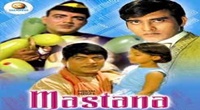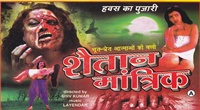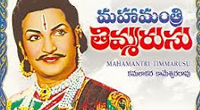This article needs additional citations for verification. (September 2015) (Learn how and when to remove this template message) |



Layla and Majnun (Arabic: ????? ?????), also Leili o Majnun (Persian: ???? ? ??????), is a narrative poem composed in 584/1188 by the Persian poet Ne??mi Ganjavi based on a semi-historical Arab story about the 7th century Bedouin poet Qays ibn Al-Mulawwah and his ladylove Layla bint Mahdi (or Layla al-Aamiriya). Nizami also wrote Khosrow and Shirin in the 12th century, a popular poem praising their love story. It is the third of his five long narrative poems, Panj Ganj (Persian: ??? ???) (The Five Treasures). Lord Byron called it “the Romeo and Juliet of the East.”
Qays and Layla fall in love with each other when they are young, but when they grow up Layla’s father doesn't allow them to be together. Qays becomes obsessed with her, and his tribe Banu Amir and the community gives him the epithet of Majn?n (????? "crazy", lit. "possessed by Jinn"). Long before Nizami, the legend circulated in anecdotal forms in Iranian akhbar. The early anecdotes and oral reports about Majnun are documented in Kitab al-Aghani and Ibn Qutaybah's al-Shi'r wal-Shu'ara'. The anecdotes are mostly very short, only loosely connected, and show little or no plot development. Nizami collected both secular and mystical sources about Majnun and portrayed a vivid picture of the famous lovers. Subsequently, many other Persian poets imitated him and wrote their own versions of the romance. Nizami drew influence from Udhrite love poetry, which is characterized by erotic abandon and attraction to the beloved, often by means of an unfulfillable longing.
Many imitations have been contrived of Nizami's work, several of which are original literary works in their own right, including Amir Khusrow Dehlavi's Majnun o Leyli (completed in 1299), and Jami's version, completed in 1484, amounts to 3,860 couplets. Other notable reworkings are by Maktabi Shirazi, Hatefi (d. 1520), and Fuzûlî (d.1556), which became popular in Ottoman Turkey and India. Sir William Jones published Hatefi's romance in Calcutta in 1788. The popularity of the romance following Nizami's version is also evident from the references to it in lyrical poetry and mystical mathnavis—before the appearance of Nizami's romance, there are just some allusions to Layla and Majnun in divans. The number and variety of anecdotes about the lovers also increased considerably from the twelfth century onwards. Mystics contrived many stories about Majnun to illustrate technical mystical concepts such as fanaa (annihilation), div?nagi (love-madness), self-sacrifice, etc. Nizami's work has been translated into many languages.
Contents
Story
Qays ibn al-Mulawwah fell in love with Layla al-Aamiriya. He soon began composing poems about his love for her, mentioning her name often. His unselfconscious efforts to woo the girl caused some locals to call him "Majnun." When he asked for her hand in marriage, her father refused because it would be a scandal for Layla to marry someone considered mentally unbalanced. Soon after, Layla was married to another noble and rich merchant belonging to the Thaqif tribe in Ta'if. He was described as a handsome man with reddish complexion whose name was Ward Althaqafi. The Arabs called him Ward, meaning "rose" in Arabic.
When Majnun heard of her marriage, he fled the tribal camp and began wandering the surrounding desert. His family eventually gave up hope for his return and left food for him in the wilderness. He could sometimes be seen reciting poetry to himself or writing in the sand with a stick.
Layla is generally depicted as having moved to a place in Northern Arabia with her husband, where she became ill and eventually died. In some versions, Layla dies of heartbreak from not being able to see her would-be lover. Majnun was later found dead in the wilderness in 688 AD, near Layla’s grave. He had carved three verses of poetry on a rock near the grave, which are the last three verses attributed to him.
Many other minor incidents happened between his madness and his death. Most of his recorded poetry was composed before his descent into madness.
| “ | I pass by these walls, the walls of Layla And I kiss this wall and that wall It’s not Love of the walls that has enraptured my heart But of the One who dwells within them |
” |
It is a tragic story of undying love much like the later Romeo and Juliet. This type of love is known as "virgin love" because the lovers never marry or consummate their passion. Other famous virgin love stories set in Arabia are the stories of Qays and Lubna, Kuthair and Azza, Marwa and Al Majnoun Al Faransi, and Antara and Abla. This literary motif is common throughout the world, notably in the Muslim literature of South Asia, such as Urdu ghazals.
History and influence
Persian adaptation and Persian literature
The story of Layla and Majnun was known in Persia as early as the 9th century. Two well known Persian poets, Rudaki and Baba Taher, both mention the lovers.[13]
Although the story was somehow known in Arabic literature in the 12th century, it was the Persian masterpiece of Nizami Ganjavi that popularized it dramatically in Persian literature. Nizami collected both secular and mystical sources about Majnun and portrayed a vivid picture of the famous lovers.[9] Subsequently, many other Persian poets imitated him and wrote their own versions of the romance.[9] Nizami drew influence from Udhrite love poetry, which is characterized by erotic abandon and attraction to the beloved, often by means of an unfulfillable longing.[10] Other influences include older Persian epics, such as V?miq u 'Adhr?, written in the 11th century, which covers a similar topic of a virgin and her passionate lover; the latter having to go through many trials to be with his love.[14]
In his adaptation, the young lovers become acquainted at school and fell desperately in love. However, they could not see each other due to a family feud, and Layla's family arranged for her to marry another man.[15] According to Dr. Rudolf Gelpke, "Many later poets have imitated Nizami's work, even if they could not equal and certainly not surpass it; Persians, Turks, Indians, to name only the most important ones. The Persian scholar Hekmat has listed no less than forty Persians and thirteen Turkish versions of Layli and Majnun."[16] According to Vahid Dastgerdi, "If one would search all existing libraries, one would probably find more than 1000 versions of Layli and Majnun."
In his statistical survey of famous Persian romances, ?asan ?ulfaq?ri enumerates 59 ‘imitations’ (na?iras) of Layla and Majnun as the most popular romance in the Iranian world, followed by 51 versions of ?osrow o Širin, 22 variants of Yusuf o Zuleikha and 16 versions of V?miq u ?A?hr?.[13]
Azerbaijani adaptation and Azerbaijani literature
The story of Layla and Majnun passed into Azerbaijani literature. The Azerbaijani language adaptation of the story, Dâstân-? Leylî vü Mecnûn (?????? ???? ? ?????; "The Epic of Layla and Majnun") was written in the 16th century by Fuzûlî and Hagiri Tabrizi. Fuzûlî's version was borrowed by the renowned Azerbaijani composer Uzeyir Hajibeyov, who used the material to create what became the Middle East's first opera. It premiered in Baku on 25 January 1908. The story had previously been brought to the stage in the late 19th century, when Ahmed Shawqi wrote a poetic play about the tragedy, now considered one of the best in modern Arab poetry. Majnun lines from the play are sometimes confused with his actual poems.
A scene of the poem is depicted on the reverse of the Azerbaijani 100 and 50 manat commemorative coins minted in 1996 for the 500th anniversary of Fuzûlî's life and activities.[17]
Other influences
The enduring popularity of the legend has influenced Middle Eastern literature, especially Sufi writers, in whose literature the name Layla refers to their concept of the Beloved. The original story is featured in Bahá'u'lláh's mystical writings, the Seven Valleys. In Arabic language, Layla name means "night," and is thought to mean "one who works by night" or "worker of the dark." This is an apparent allusion to the fact that the romance of the star-crossed lovers was hidden and kept secret. In the Arabic language, the word Majnun means "a crazy person." In addition to this creative use of language, the tale has also made at least one linguistic contribution, inspiring a Turkish colloquialism: to "feel like Mecnun" is to feel completely possessed, as might be expected of a person who is literally madly in love.
This epic poem was translated into English by Isaac D'Israeli in the early 19th century allowing a wider audience to appreciate it.
Layla has also been mentioned in many works by Aleister Crowley in many of his religious texts, including The Book of Lies.
In India, it is believed that Layla and Majnun found refuge in a village in Rajasthan before they died. The graves of Layla and Majnun are believed to be located in the Bijnore village near Anupgarh in the Sriganganagar district. According to rural legend there, Layla and Majnun escaped to these parts and died there. Hundreds of newlyweds and lovers from India and Pakistan, despite there being no facilities for an overnight stay, attend the two-day fair in June.
Another variation on the tale tells of Layla and Majnun meeting in school. Majnun fell in love with Layla and was captivated by her. The school master would beat Majnun for paying attention to Layla instead of his school work. However, upon some sort of magic, whenever Majnun was beaten, Layla would bleed for his wounds. The families learnt of this strange magic and began to feud, preventing Layla and Majnun from seeing each other. They meet again later in their youth and Majnun wishes to marry Layla. Layla's brother, Tabrez, would not let her shame the family name by marrying Majnun. Tabrez and Majnun quarreled and, stricken with madness over Layla, Majnun murdered Tabrez. Word reached the village and Majnun was arrested. He was sentenced to be stoned to death by the villagers. Layla could not bear it and agreed to marry another man if Majnun would be kept safe from harm in exile. Her terms were accepted and Layla got married, but her heart still longed for Majnun. Hearing this, Layla's husband rode with his men into the desert to find Majnun. Upon finding him, Layla's husband challenged Majnun to the death. The instant her husband's sword pierced Majnun's heart, Layla collapsed in her home. Layla and Majnun were buried next to each other as her husband and their fathers prayed to their afterlife. Myth has it that Layla and Majnun met again in heaven, where they loved forever.
Popular culture
- The tale and the name "Layla" served as Eric Clapton's inspiration for the title of Derek and the Dominos' famous album Layla and Other Ass
Watch movie Laila Majnu online on Amazon
Watch movie Laila Majnu online
Watch The Movie On PrimeAakhri Adaalat Full HD Movie Download

Mastana Full HD Movie Download

Paapi Devta Full HD Movie Download

Pet Pyar Aur Paap Full HD Movie Download

Free Love Full HD Movie Download

Deewana Tere Naam Ka (1987) Full HD Movie Download
.jpg)
Nazrana (1987) Full HD Movie Download
.jpg)
Geet (1992) Full HD Movie Download
.jpg)
Chak Jawana Full HD Movie Download

Kaminey Full HD Movie Download

Yeh Raaste Hain Pyar Ke (1963) Full HD Movie Download
.jpg)
Shaitan Mantrik Full HD Movie Download

Vat Pahte Sunechi Full HD Movie Download

Modala Sala Full HD Movie Download

Assembly Rowdy Full HD Movie Download

Return Of Khuda Gawah Full HD Movie Download

Shabnam Full HD Movie Download

Sandhwanam Full HD Movie Download

Pranam Full HD Movie Download

Maha Mantri Timmarusu Full HD Movie Download

Indru Poi Naalai Vaa Full HD Movie Download

Download latest Movie from bollywood
- 1> baaghi 3
- 2> THE SKY IS PINK MOVIE FULL STORY AND REVIEW
- 3> Luka Chuppi
- 4> TO ALL THE BOYS I’VE LOVED BEFORE
- 5> Kabir Singh
- 6> Street Dancer 3D
- 7> Simmba
- 8> Gone Girl
- 9> The Girl Who Lived
- 10> Ludo
- 11> DILWALE DULHANIA LE JAYENGE
- 12> GUILTY
- 13> The Godfather
- 14> Adventures of Rusty
- 15> Sooryavanshi
- 16> Satyameva Jayate 2
- 17> Thappad
- 18> Bhool Bhulaiyaa 2
- 19> KGFChapter 2
- 20> Mardaani 2
- 21> Pinjar
- 22> Shivaji maharaj
- 23> Ek Villian 2
- 24> Hungama 2
- 25> Divergent
- 26> Mumbai Saga
- 27> The Internship
- 28> HIT (telugu)
- 29> Panga
- 30> The perfect date
- 31> 16 December
- 32> Gopala Gopala (Telugu)
- 33> Brahmastra
- 34> Gangubai Kathiawadi
- 35> Manmadhudu
- 36> Nenu local
- 37> Mahanati
- 38> Shatamanam bavathi
- 39> Lagaan
- 40> After
- 41> MOM
- 42> Shamshera
- 43> Raguvaran BTech
- 44> Khakee
- 45> The villain
- 46> OM
- 47> Mr. perfect
- 48> Bueatifull mind
- 49> Hichki
- 50> Gabbar Singh
- 51> Jogi
- 52> Before Sunrise
- 53> Before Sunset
- 54> Before Midnight
- 55> The Big Bull
- 56> Top Gun: Maverick
- 57> The Purge
- 58> The Sky is Pink
- 59> Laxmmi Bomb
- 60> Sadak 2
- 61> Sufna
- 62> Prithviraj
- 63> PK
- 64> Coolie No 1(2020)
- 65> Black Widow
- 66> Dear Zindagi
- 67> Dil Bechara
- 68> PHIR HERA PHERI
- 69> WAR
- 70> Dostana
- 71> RRR: Roudram Ranam Rudhiram
- 72> Maidan
- 73> Dabbang 3
- 74> Chhalaang
- 75> life as we know it
- 76> SherShaah
- 77> Sandeep Aur Pinky Faraar
- 78> Event Horizon
- 79> 83
- 80> Radhe: Your Most Wanted Bhai
- 81> Gunjan Saxena: The Kargil Girl
- 82> Mr India
- 83> Vivah
- 84> Anokha Bandhan
- 85> Ghost
- 86> Bhoot: Part One - The Haunted Ship
- 87> Haseen Dilruba
- 88> Laal Singh Chaddha
- 89> Qismat
- 90> Rajput
- 91> Drive
- 92> Dil Chahta Hai
- 93> Dil Ki Baazi
- 94> Dil Ka Rishta
- 95> Teesri Manzil
- 96> Dil
- 97> Love Aaj Kal
- 98> Khaali Peeli
- 99> Bunty Aur Babli 2
- 100> Atrangi Re
- 101> Gulabo Sitabo
- 102> Jodi
- 103> Suraj Pe Mangal Bhari
- 104> Deewana
- 105> Attack
- 106> Sardar Udham Singh
- 107> Toofan
- 108> THE LOVEBIRDS
- 109> Jersey
- 110> Ginny Weds Sunny
- 111> Thalaivi
- 112> Shiddat
- 113> Angels vs Zombies
- 114> Koi Mil Gya
- 115> Thank God
- 116> Bhuj: The Pride of India
- 117> Hum Aapke Hain Kaun
- 118> The Platform
- 119> Bird Box
- 120> Roohi Afzana
- 121> Torbaaz
- 122> Nikamma
- 123> World War Z
- 124> Extraction
- 125> Train to Busan
- 126> Life of Pi
- 127> SHAADI MEIN JROOR AANA
- 128> Himmat Aur Mehnat
- 129> To All The Boys: P.S. I Still Love You
- 130> Mimi
- 131> Good Newwz
- 132> Shubh Mangal Zyada Saavdhan
- 133> Raabta
- 134> Harry Potter and the Philosopher's Stone
- 135> Harry Potter and the Chamber of Secrets
- 136> Chhapaak
- 137> War of the Worlds
- 138> Harry Potter and the Prisoner of Azkaban
- 139> Harry Potter and the Goblet of Fire
- 140> MURDER MYSTERY
- 141> Shakuntala Devi
- 142> Bachchan Pandey
- 143> Jayeshbhai Jordar
- 144> Sheer Qorma
- 145> Saina
- 146> 'O' Pushpa I hate tears
- 147> Kedarnath
- 148> MS Dhoni The Untold Story
- 149> Chhichhore
- 150> Badhaai Ho
- 151> Unstoppable
- 152> Oz the Great And Powerful
- 153> The Girl on the Train
- 154> Haathi Mere Saathi 2020
- 155> The Conjuring: The Devil Made Me Do It
- 156> Gandhi Se Pehle Gandhi
- 157> The Song of Scorpions
- 158> Srimanthudu
- 159> Hello Guru Prema Kosame
- 160> Beauty and The Beast
- 161> Black Panther
- 162> Charlie and the Chocolate Factory
- 163> Bole Chudiyan
- 164> Fidaa
- 165> Duvvada Jagannadham
- 166> Bruce Lee: The Fighter
- 167> Hyper
- 168> Yaara
- 169> Red (2020)
- 170> Shivam
- 171> That Is Mahalakshmi
- 172> Nishabdham
- 173> Aashram 2020 web series
- 174> Laxmii
- 175> Mismatched
- 176> STUDENT OF THE YEAR 2
- 177> NAIL POLISH
- 178> Ramprasad Ki Tehrvi
- 179> KAAGAZ
- 180> 12 o Clock
- 181> The Power
- 182> bolo hau
- 183> Tribhanga
- 184> JAMUN
- 185> Madam Chief Minister
- 186> Maasaab
- 187> Aadhaar
- 188> Tanhaji
- 189> Bhaagi 3
- 190> Bhootnath
- 191> MALANG
- 192> Jai Mummy Di
- 193> Haathi Mere Saathi 2021
- 194> Shakeela
- 195> Unpaused
- 196> Annayya
- 197> Vamsoddharakudu
- 198> Mrugaraju
- 199> Narasimha Naidu
- 200> Sankranti
- 201> Manasu Maata Vinadhu
- 202> Anjaane
- 203> Apaharan
- 204> Bachke Rehna Re Baba
- 205> Bewafaa
- 206> Roohi
- 207> Radhe
- 208> Zindagi Khoobsoorat Hai
- 209> Yeh Mohabbat Hai
- 210> Yeh Kya Ho Raha Hai?
- 211> The Tomorrow War
- 212> DehradunDiary
- 213> Meri Shaadi Karaoo
- 214> Matruu Ki Bijlee Ka Mandola
- 215> No One Killed Jesica
- 216> Aag Ka Goola
- 217> Eight Million Dollars
- 218> Three Hundred
- 219> Cats and Dog
- 220> Decoy
- 221> Gold Rush
- 222> You Have Got Mail
- 223> Final Destination three
- 224> Tofan
- 225> Jungle
